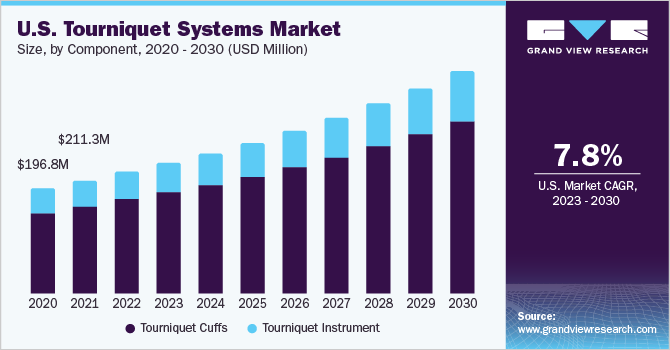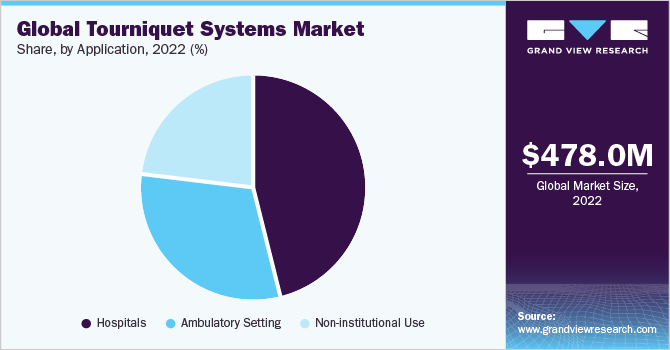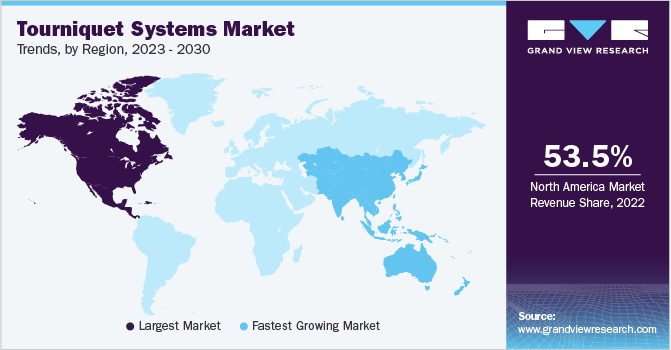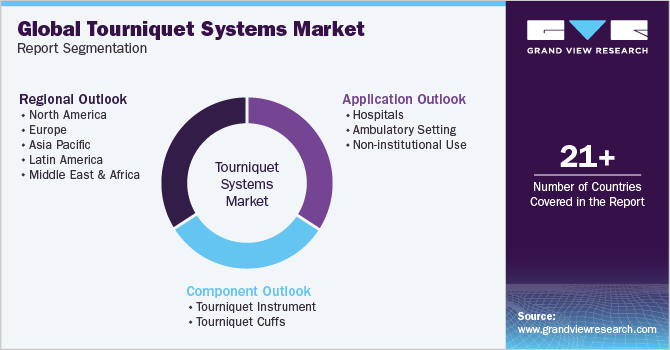- Home
- »
- Medical Devices
- »
-
Tourniquet Systems Market Size, Share, Growth Report 2030GVR Report cover
![Tourniquet Systems Market Size, Share & Trends Report]()
Tourniquet Systems Market Size, Share & Trends Analysis Report By Component (Tourniquet Instrument, Tourniquet Cuffs), By Application (Hospitals, Ambulatory Setting), By Region, And Segment Forecasts, 2023 - 2030
- Report ID: GVR-1-68038-817-6
- Number of Report Pages: 100
- Format: PDF, Horizon Databook
- Historical Range: 2018 - 2021
- Forecast Period: 2023 - 2030
- Industry: Healthcare
Report Overview
The global tourniquet systems market size was estimated at USD 478.0 million in 2022 and is anticipated to grow at a compound annual growth rate(CAGR) of 7.9% from 2023 to 2030. A rise in the geriatric population, which is highly susceptible to orthopedic conditions, coupled with increasing patient awareness, is expected to drive the market growth over the forecast period. Moreover, musculoskeletal disorders, accidents, and bone disorders have led to the rising demand for tourniquet systems, thereby facilitating market growth. The COVID-19 pandemic had a significant impact on the market growth and it underwent a decline during the first half of 2020. The pandemic impacted the healthcare sector on a global level including tourniquet sales leading to a decline in revenue.

The crisis caused by the pandemic led to supply chain disruption, inadequate access to raw materials, and production delays that affected the market, as the products were not available. However, the healthcare services regained traction and the market resumed gradually to the pre-pandemic volumes in 2021. In hospitals, tourniquets are specifically used during orthopedic surgeries, where external hemorrhage cannot be controlled by direct pressure. In addition, the device is also used during emergencies and life-threatening limb hemorrhages or limb amputations with multiple bleeding points, for immediate management of breathing & airway problems.
However, restraints, such as the transmission of infection, due to reusable cuffs might consequently increase hospital costs and hinder the growth of the market. A spike in the various kinds of accidents, such as falls, road accidents, and industrial accidents, causes more patients to be admitted to the hospitals, which, in turn, is causing more use of tourniquets in cases of emergency admissions. The emerging cases of joint replacement surgeries, musculoskeletal disorders, plastic surgeries, and extreme orthopedic conditions, such as fractures, are expected to significantly drive the market growth.
A tourniquet is highly useful in these surgeries as it offers greater flexibility and visibility to the doctors and helps reduce the blood flow. According to a report by the Centre for Disease Control & Prevention (CDC), around 2.6 million people are diagnosed with osteoporosis accelerating the demand for orthopedic surgical treatment. The increasing prevalence of such conditions and diseases is expected to fuel the demand for tourniquet systems.Hospitals and other healthcare facilities have become more accessible and affordable to the public, creating a positive impact on hospital admission rates and hence, resulting in increasing access to healthcare facilities.
Similarly, there has been a boost in the economy in recent years, which is contributing to the fact that the average income of people around the globe has increased. It is the responsibility of the U.S. Food and Drug Administration (FDA) to ensure Good Manufacturing Practice (GMP) in the supply, storage, and packaging of tourniquets so that the patient’s safety is maintained without hampering the effectiveness of the product. Apart from the FDA, there are other regulatory bodies that are responsible for maintaining the norms, such as public health systems, state and local health departments, and medical device manufacturers.
Component Insights
The tourniquet cuffs segment dominated the market with the largest revenue share in 2022. The increasing adoption of tourniquet cuffs in orthopedics, lower limb injuries, and joint replacement surgeries is expected to drive the segment growth over the forecast period. The pneumatic cuffs segment is expected to grow at the fastest CAGR over the forecast period from 2023 to 2030.
This is owing to their ability to provide a standardized pressure that can be easily controlled and the compression is independent of the position and strength of the medical expert’s hand. Rapid technological advancements in the field of pneumatic cuffs are expected to boost the market growth over the forecast period. For instance, Zimmer Biomet launched the A.T.S 5000 & 2200 personalized tourniquet system to reduce the post-operative pain of patients. Its features include dual port accessibility, a touchscreen user interface, and personalized pressure customization.
Application Insights
The hospital segment dominated the market with the largest revenue share of 46.3% in 2022 and is expected to grow at the fastest CAGR of 8.1% over the forecast period. Tourniquet systems are extensively adopted in hospitals as an essential tool for the management of life-threatening external hemorrhages caused by lower limb injury. The rising average income ensures easy accessibility and affordability for hospital settings. Advanced diagnostics with enhanced operability and a varied range of treatments including tourniquet systems are expected to drive the growth in this segment.

The non-institutional segment is expected to witness lucrative growth over the forecast period owing to the increasing application of tourniquets in military settings and war sites. Limb hemorrhages are one of the most common injuries caused by military wars. According to the National Center for Biotechnology Information, the “point of significant hemorrhage from limb is not peripherally accessible due to entrapment” (during times when simple methods of hemorrhage control, such as direct pressure, cannot be adopted). In such cases, tourniquets can prove to be lifesaving without resulting in complications.
Regional Insights
North America dominated the market and accounted for the largest revenue share of 53.5% in 2022 owing to factors, such as the presence of well-established healthcare infrastructure, a large target population, and the high adoption rate of technologically advanced systems. According to a report by the CDC, around 32 million people in the U.S. suffer from a degenerative bone disorder and this number is likely to increase in the future. In addition, according to an article by Newspaper USA Today, the U.S. doctors were encouraging the general public, cops, and firefighters to be trained in quick techniques for stopping bleeding in case of road, rail, or fire injuries or any other kind of emergency,whichaugmented the product demand.

On the other hand, Asia Pacific is expected to grow at the fastest CAGR of 8.7% over the forecast period. Emerging economies, such as India and Indonesia,are experiencing growth with respect to population and the increasing number of accidents might spur the demand for tourniquets in the region. The region is also expected to benefit from the growing number of hospitals and laboratory settings, wherein the application of the tourniquet system is maximum.
Key Companies & Market Share Insights
A rise incompetition is leading to rapid technological advancements, and companies are working toward the improvement of their products with a major focus on research and development. Major companies are implementing various business strategies, such as mergers & acquisitions, collaborations, and product launches, to strengthen their industry presence. In August 2022, SourceMark Medical announced that it was awarded a group purchasing agreement with Premier, Inc. for its Tourniquet Touch Pneumatic Tourniquet system. The new agreement permits Premier members to take advantages related to pricing & pre-negotiated terms by Premier for the system.Some of the prominent players in the global tourniquet systems market include:
-
Delfi Medical Innovations Inc.
-
Zimmer Biomet
-
Hammarplast Medical AB
-
VBM Medizintechnik GmbH
-
Stryker
-
Ulrich Medical
-
Rudolf Riester GmbH
-
AneticAid
Tourniquet Systems Market Report Scope
Report Attribute
Details
Market size value in 2023
USD 514.3 million
Revenue forecast 2030
USD 873.3 million
Growth rate
CAGR of 7.9% from 2023 to 2030
Base year for estimation
2022
Historical data
2018 - 2021
Forecast period
2023 - 2030
Report updated
September 2023
Quantitative units
Revenue in USD million and CAGR from 2023 to 2030
Report coverage
Revenue forecast, company ranking, competitive landscape, growth factors, and trends
Segments covered
Component, application, region
Regional scope
North America; Europe; Asia Pacific; Latin America; MEA
Country scope
U.S.; Canada; UK; Germany; France; Italy; Spain; Denmark; Sweden; Norway; Japan; China; India; Australia; South Korea; Thailand; Brazil; Mexico; Argentina; Saudi Arabia; South Africa; UAE; Kuwait
Key companies profiled
Delfi Medical Innovations Inc.; Zimmer Biomet; Hammarplast Medical AB; VBM Medizintechnik GmbH; Stryker; Ulrich Medical; Rudolf Riester GmbH; AneticAid
Customization scope
Free report customization (equivalent up to 8 analyst’s working days) with purchase. Addition or alteration to country, regional & segment scope
Pricing and purchase options
Avail customized purchase options to meet your exact research needs. Explore purchase options
Global Tourniquet Systems Market Report Segmentation
This report forecasts revenue growth at global, regional, and country levels and provides an analysis of the latest trends in each of the sub-segments from 2018 to 2030. For this study, Grand View Research has segmented the global tourniquet systems market report on the basis of component, application, and region:

-
Component Outlook (Revenue, USD Million, 2018 - 2030)
-
Tourniquet Instrument
-
Tourniquet Cuffs
-
Pneumatic
-
Disposable
-
Reusable
-
-
Non-pneumatic
-
-
-
Application Outlook (Revenue, USD Million, 2018 - 2030)
-
Hospitals
-
Ambulatory Setting
-
Non-institutional Use
-
-
Regional Outlook (Revenue, USD Million, 2018 - 2030)
-
North America
-
U.S.
-
Canada
-
-
Europe
-
UK
-
Germany
-
France
-
Italy
-
Spain
-
Denmark
-
Sweden
-
Norway
-
-
Asia Pacific
-
Japan
-
China
-
India
-
Australia
-
Thailand
-
South Korea
-
-
Latin America
-
Brazil
-
Mexico
-
Argentina
-
-
Middle East & Africa
-
South Africa
-
Saudi Arabia
-
UAE
-
Kuwait
-
-
Frequently Asked Questions About This Report
b. The global tourniquet systems market size was estimated at USD 478.0 million in 2022 and is expected to reach USD 514.4 million in 2023.
b. The global tourniquet systems market is expected to grow at a compound annual growth rate of 7.9% from 2023 to 2030 to reach USD 873.4 million by 2030.
b. In terms of application area, Hospitals dominated the tourniquet systems market with a share of 46.3% in 2022. This is attributable to the rising incidence of road accidents that require tourniquet systems to manage a life-threatening injury.
b. Some key players operating in the tourniquet systems market include Delfi Medical, Zimmer Biomet, Hammarplast Medical AB, VBM Medizintechnik GmbH, Stryker, ulrich medical, and Rudolf Riester GmbH.
b. Key factors that are driving the market growth include rise in geriatric population, which is highly susceptible to orthopedic conditions, increasing patient awareness, greater flexibility, and reliability of latest innovative tourniquet systems.
Share this report with your colleague or friend.
![gvr icn]()
NEED A CUSTOM REPORT?
We can customize every report - free of charge - including purchasing stand-alone sections or country-level reports, as well as offer affordable discounts for start-ups & universities. Contact us now
![Certified Icon]()
We are GDPR and CCPA compliant! Your transaction & personal information is safe and secure. For more details, please read our privacy policy.
We are committed towards customer satisfaction, and quality service.
"The quality of research they have done for us has been excellent."





